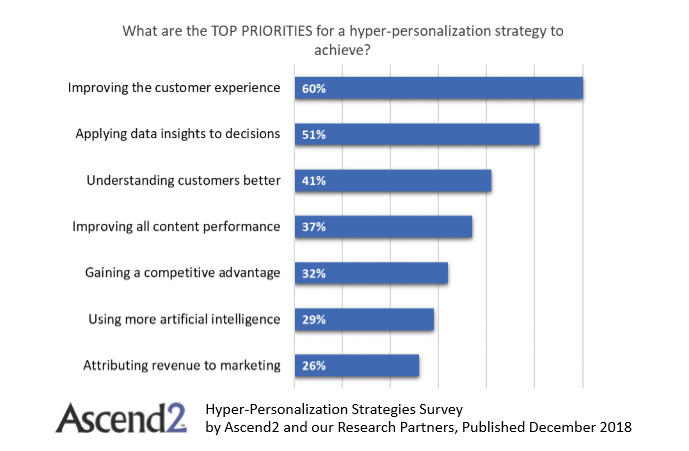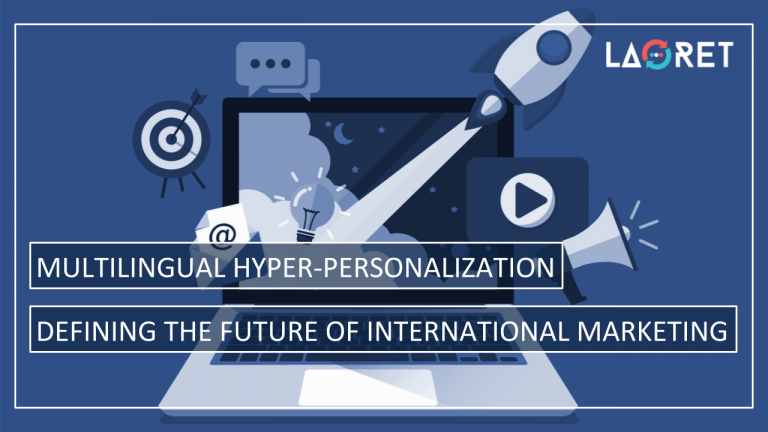Multilingual Hyper-Personalization: Defining The Future Of International Marketing
Marketing is about understanding people. And since peoples needs are constantly changing, so should marketing techniques. For the last few years, a term called hyper-personalization has been popping up in marketing guides as the next new frontier in targeted marketing strategies. More specifically, it uses Artificial Intelligence (AI) to collect data on buyers, so they can offer the most personalized buyer information possible. But how many out there are already applying it? Go multilingual!
According to research by Ascend2,7 only 9% of marketing agencies had applied hyper-personalization in their workflow back in 2018. For the last 2 years, a lot of agencies have joined in the debate, but there remains a golden opportunity for those ready to apply it now.
But when you do, go a step further. Make your hyper-personalization a multilingual one, and the benefits you reap will be even greater. Let us expand on the best way that multilingual hyper-personalization should be introduced into your workflow.

The Native Experience Has Gone Hyper
Hasn’t personalization always been at the heart of effective marketing? Sure. We are all familiar with emails like Hi Mieke. You recently purchased this product. Here are similar ones you will like! This is an example of how most eCommerce businesses are applying personalization today. However, the nature of what reaches people effectively has intensified.
According to recent numbers by Deloitte,8 22 percent of online consumers will be more than happy to provide business with extra details if it means they will get more personalized offers. What’s more, one in five customers is not only interested in receiving personalized products, they are also willing to pay 20% more to receive them.
Consumer’s shopping behaviors are speaking for themselves: they want marketing to get as personal as it gets and are in some cases even willing to pay more to get it. This is why hyper-personalization goes a step further. Since hyper-personalization uses AI, it offers the most personalized buyer information possible. Now the question is, how can this be applied in a multilingual strategy?
Multilingual Hyper-Personalization: The Localization Strategy To Follow
When applying multilingual hyper-personalization, you can’t do so aimlessly. Make sure you have a sound strategy in place and that you follow the best practices for localization as well the hyper-personalization priorities. Here’s how!
Create A More Personalized buyer’s Journey
Ascend2’s previously mentioned report has yielded some more valuable insights to consider. Based on the results of their survey, they have short-listed some priorities you ought to keep in mind when applying a hyper-personalization strategy. The two main priorities, the survey suggests, should be about improving customer experience (60 percent) and applying data insights to decisions (51 percent).

First, let’s talk about this 51 percent priority to apply data insights to decisions. Since hyper-personalization seeks to offer new insights based on data collection, this is where you need to start before you have materials you can localize.
Users are providing you with information all the time, and it is your responsibility to develop a strategy around the data you receive. You can discern a lot from who is visiting you, from where, how often, and which pages they are interacting with the most. For your website, you can keep a close eye on Google Analytics and Google Console, and use the data to further personalize the buyer journey.
But you can also apply the strategy to mobile users. By the end of 2019, mobile phone users had reached 4,68 billion.9 This means they are an invaluable resource to marketers looking to target multilingual audiences. By zoning in on the mobile user’s location, targeted messaging can be shared with the right person, at the right place, at right time. This strategy is built around so-called Geo-Fencing. This strategy utilizes latitude and longitude data to determine locations so that the messaging can be sent out based on geography. The geo-fencing market is projected to reach 1,825.3 Million by 2022.10
Make Customer Experience Your Top Priority
Back to the report! It looks like the top priority should go to customer experience. Where does language fit into this experience and why does it matter? According to recent research by Shopify,11 59 percent of online buyers will rarely shop on sites that only have English options available, and 75 percent desire to buy in their native language. So, when you want to combine a multilingual strategy with localization, hyper-personalization becomes vital.
Localization goes beyond translation and adds cultural potency targeted on a regional level. This means that preferences in design, idioms, local sensitivities and even colors are considered. What would this look like in a practical and workable model? Let’s look at it a bit more closely.
Localize Your Website And Apps
The numbers don’t lie, people want to shop in their own language. So, website localization is an absolute must. With website localization, linguistic and cultural adaptations are needed, but the technical side shouldn’t be neglected. Make sure you connect with a vendor who can provide native linguists for the linguistic and cultural adaptations, and localization engineers to make sure everything runs smoothly.
Do you have an app alongside your website that you use to sell your products or communicate your service? Then your app needs localizing as well. The in-app content, non-string content, and in-store content will all be translated following the Translating, Proofing and Editing (TEP) Process. To ensure that all your updates are translated and inserted in a bug-free way, you should also make sure to request continuous localization services.
Pro Tip! Does mobile app localization sound like a rather complex endeavor? Have a look at our blog on how Mobile App Localization can be applied as a smart business strategy and also get a handy list of qualities top vendors should possess.
Multilingual Hyper-Personalization And Customer Service
Multilingual chatbots
are set to change the way we interact with the consumer who wants native support, but also at a record speed.12 In order to meet local expectations, consider translating the chatbot script to all your target languages.
The rise of multilingual chat bots also come with an increased interest in Machine Translation. But beware, only apply this where you can. Some content will require that hyper-personal touch to be successful, and other parts of the process just need to run smoothly to complete the buyer’s journey in an effective way. Keep up with multilingual consumer inquiries using Machine Translation Post-Editing (MTPE). This means that a MT will be submitted to human editing and review before being sent out.
Pro tip! Learn more about how Machine Translation Post Editing can benefit you in our blog outlining the best MTPE practices! You will also learn all about how the MT-Engine output can be improved so that human editing can be more efficient.
Multilingual Hyper-Personalized Marketing Messages
Multilingual Marketing Messages are the targeted results of all the data you collected. This is why this type of content is a great example where you should stay far away from Machine Translation and only human translators should touch the content. Marketing messaging can include anything from newsletters and email marketing, to ad campaigns and social media. The core of what defines these messages, is understanding your audience through and through.
This is why two strategies can be selected to be applied here. The above-mentioned localization, and transcreation. One thing we have learned talking to our clients, is that localization is a service they love for websites, apps, games, software, and so on, but for their marketing messages they can be a little bit more particular and not sure which way to go.
Depending on the quality of the source text, a service called transcreation can be applied. Transcreation combines translation and creation. While localization goes from a perfect source text and industry-specialized linguists are set the task to localize the content, transcreation can be used even without a source text. Any source text provided would be used as a concept more than a loyal reference, and linguists as well as native copywriters are set the task of sculpting perfect, local copy.
Pro tip! When should you choose transcreation and when not? Check out our blog on when transcreation will benefit you, and when it will not. Have you already decided you’d like transcreation services? Great, then have a look at our blog on best transcreation practices!
Conclusion:
Hyper-Personalization is on the rise, and if you would like to get in on the action, you should start implementing it in your marketing strategies now. To give you a global edge, combine this with multilingual hyper-personalization, where effective localization and translation methods are applied alongside your local marketing.
At Laoret, we combine the expertise of marketing specialists with native linguists and localization engineers. Our localization and transcreation services are designed so that every market is treated in a unique way, so that your copy will have the biggest possible impact.
- Hyper-Personalization Strategies
- Connecting meaningfully in the new reality
- Worldwide Mobile Users
- The Geofencing Market
- Global eCommerce Statistics
- Multilingual Chatbots Will change the voice of business
- Hyper-Personalization Strategies
- Connecting meaningfully in the new reality
- Worldwide Mobile Users
- The Geofencing Market
- Global eCommerce Statistics
- Multilingual Chatbots Will change the voice of business






